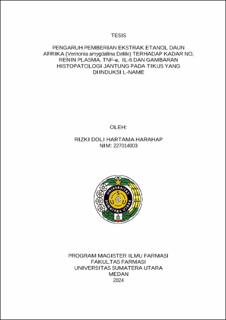Pengaruh Pemberian Ekstrak Etanol Daun Afrika (Vernonia amygdalina Delile) terhadap Kadar No, Renin Plasma, TNF-α, IL-6 dan Gambaran Histopatologi Jantung pada Tikus yang Diinduksi L-Name
Effect of Bitter Leaf (Vernonia amygdalina Delile) Etanol Extract on Levels of No, Plasma Renin, TNF-α, IL-6 and Cardiac Histopathological Features in L-Name Induced Rats

Date
2024Author
Harahap, Rizki Doli Hartama
Advisor(s)
Harahap, Urip
Dalimunthe, Aminah
Metadata
Show full item recordAbstract
Background: Hypertension is defined as high blood pressure with a systolic pressure greater than equal to 140 mmHg and a diastolic pressure greater than equal to 90 mmHg. According to the World Health Organisation (WHO) in 2019, 1.13 billion people worldwide suffered from hypertension. African leaf (Vernonia amygdalina Delile) is high in antioxidants and has many pharmacological effects such as antihypertensive and cardioprotective.
Purpose: This study aimed to analyse the effects of ethanol extract of African leaf (Vernonia Amygdalina Del.) on the levels of nitric oxide, plasma renin, TNF- α, IL-6 and cardiac histopathology in L-NAME-induced rats.
Methods: This study was conducted experimentally, namely testing the cardioprotective effectiveness of ethanol extract of African leaves in hypertension model rats and then examining heart histopathology using HE staining and analysing parameters, namely NO, plasma renin, TNF- α and IL-6 levels. This study used 6 groups, each group consisted of 5 male rats, namely the normal group, negative control by administering L-NAME 40 mg/kgBB, positive control by administering L-NAME plus lisinopril 2.5 mg/kgBB, EEDA 100 mg/kgBB, EEDA 300 mg/kgBB and EEDA 500 mg/kgBB. This research stage includes the preparation of ethanol extract of African leaves, phytochemical screening, standardisation of extracts and testing the effectiveness of African leaves on rat heart damage. Data were analysed using one-way ANOVA with p<0.05.
Results: L-NAME produces heart damage such as degeneration and necrosis of heart cells. In the negative control, NO levels were 13.00 ± 2.12 ng/mL while the group given EEDA, the group with a dose of 500 mg/kgBB there was an increase in NO close to the normal group which was 36.00 ± 12.94 ng/mL. In the positive control group, the increase in NO levels was 38.00 ± 9.74 ng/mL. In the negative group, plasma renin levels were 40.60 ± 9.98 ng/mL while the EEDA group with a dose of 500 mg / kgBB had the highest plasma renin decrease compared to other EEDA groups and positive controls, namely 13.80 ± 1.30 ng/mL. In the positive control group, plasma renin levels were 14.20 ± 1.79 ng/mL. In the negative group, TNF-α levels were 25.36 ± 5.95 pg/mL while the group given EEDA dose of 500 mg/kgBB decreased TNF-α close to the normal group of 1.16 ± 0.83 pg/mL. In the positive control group, the decrease in TNF-α levels was 0.89 ± 0.60 pg/mL. In the negative control group, IL-6 levels were 4.80 ± 1.30 pg/mL while the group given EEDA at a dose of 500 mg/kgBB experienced a decrease in IL-6 which was 1.52 ± 0.. In the positive control group, there was a decrease in IL-6 levels of 0.77 ± 0.20 ng/mL.
Conclusion: EEDA increases NO levels, reduces plasma renin, TNF- α, IL-6 levels, improves the condition of cardiac cell degeneration and necrosis.
Collections
- Magister Theses [360]
